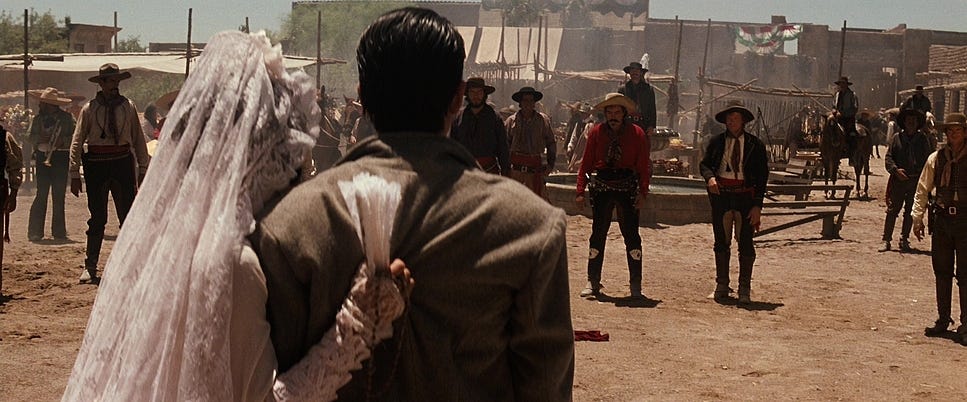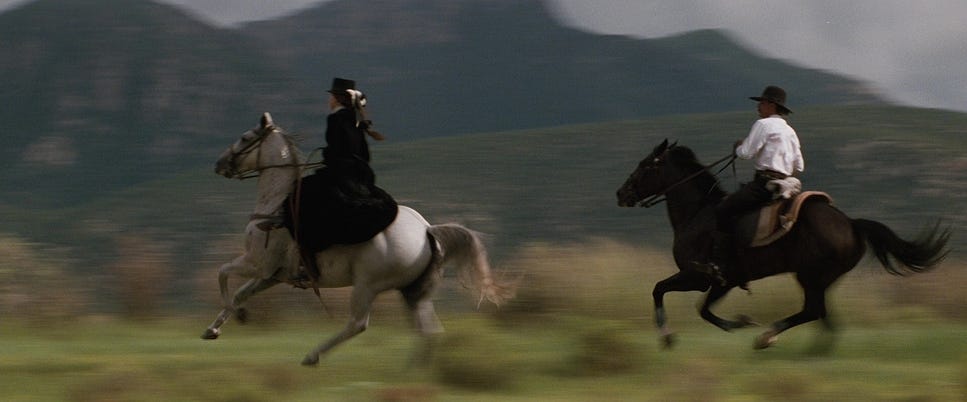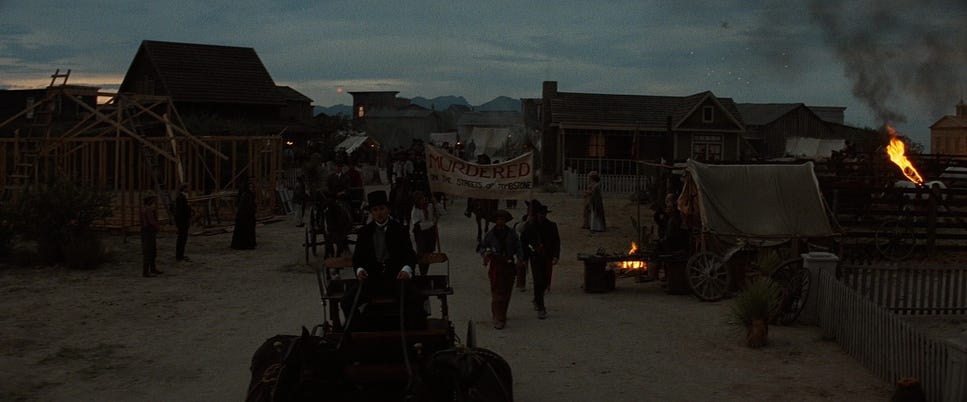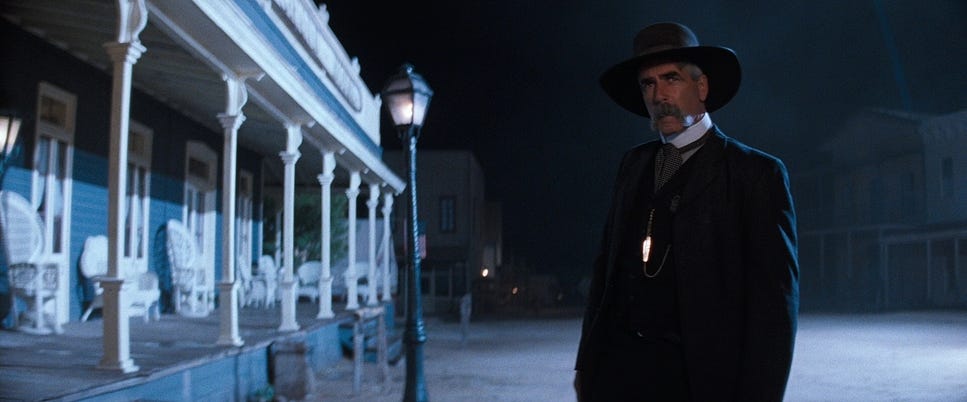Reel Breakdown #70: TOMBSTONE (1993)
How a Gritty, Star-Driven Western Brought the Genre Back from the Dead
There are Westerns that honor tradition and Westerns that break it. Tombstone somehow does both, and that’s why it stands out: its blend of gritty spectacle and emotional heft both honors and redefines the genre. Val Kilmer's Doc Holliday is one of cinema’s most magnetic, tragic figures.
Why revisit Tombstone now? Its cult legacy, quotable performances, and notorious production add to a mythos built on loyalty, mortality, and redemption. Tombstone proves that commitment to these enduring themes and charismatic acting can still enthrall the Western in an era of genre fatigue.
Drawn by its reputation, I discovered Tombstone as a revisionist Western: it embraces and subverts classic shootout tropes, thanks to '90s star power and substantial rewatch value. This blend helped revive and redefine the genre.
Let’s break it down.
The Director*
George P. Cosmatos (officially) / Kurt Russell (unofficially)
Notable works before: Rambo: First Blood Part II (1985), Leviathan (1989)
Notable after: Shadow Conspiracy (1997)
Cosmatos was known for workmanlike action, but Tombstone isn’t solely his. Kurt Russell reportedly ghost-directed planning scenes, shots, and performances while Cosmatos covered as the director.
Direction is tight and character-driven, a departure from Cosmatos’s usual bombast. Restraint and elegance in quiet scenes benefit the tone and underscore actor-led authorship, echoing Open Range or Eastwood’s late Westerns.
Cinematography & Camera Work
Cinematographer: William A. Fraker
Camera: Panavision Panaflex Gold
Aspect Ratio: 2.39:1
Lenses: Panavision Primo lenses
Film Stock: 35mm, Eastman's 5247 100T II
Fraker (Rosemary’s Baby, Bullitt, WarGames) brings a painter’s eye: sunburnt landscapes, warm saloon lighting, and choreographed gunfights. The color palette — featuring earth, red, and gunmetal blues — is stylized yet grounded.
Framing stays classical: wide shots for duels, close-ups for emotion, and strong silhouettes for mythic scale. Symmetry recurs in moral reckonings, with blocking echoing classic Western iconography.
The iconic OK Corral sequence is worth studying for its tension-building lens work and subtle dolly movements — suspense born not from editing, but from where the eye is led.
The Cast & Acting Performances
Kurt Russell as Wyatt Earp — The film’s stoic, conflicted moral center.
Val Kilmer as Doc Holliday — Charismatic, tragic, and fiercely loyal gambler.
Sam Elliott is Virgil Earp, Wyatt’s steadfast older brother and lawman.
Bill Paxton as Morgan Earp — Idealistic, innocent, youngest Earp brother.
Powers Boothe as Curly Bill Brocius — Charismatic, ruthless leader of the Cowboys.
Michael Biehn as Johnny Ringo — Intelligent, violent foil to Holliday.
Dana Delany as Josephine Marcus — Traveling actress; Wyatt’s love interest.
Stephen Lang as Ike Clanton — Volatile, cowardly recurring antagonist.
Thomas Haden Church as Billy Clanton — Hot-headed younger outlaw.
Charlton Heston as Henry Hooker — Wealthy rancher aiding the Earps.
Terry O’Quinn as Mayor Clum — Reformist city leader.
Jason Priestley as Billy Breakenridge — Conflicted young deputy.
Billy Zane is Mr. Fabian, a Shakespearean actor and companion to Josephine.
John Corbett as Creed Johnson — Cowboy, minor presence.
Billy Bob Thornton as Johnny Tyler — Belligerent gambler in early scene.
Harry Carey Jr. as Marshal Fred White — Outmatched local lawman.
Kilmer’s performance as Doc Holliday is the kind of alchemy you rarely see. He’s sickly but dangerous, charming yet haunting, and steals every scene with a whisper and a smirk. It’s his finest role, full stop — and arguably one of the most outstanding supporting performances of the '90s. ("I’m your huckleberry" is cultural scripture now.)
Kurt Russell, stoic and burdened, embodies the morally torn Wyatt. His quiet strength turning to violent resolve is nuanced, and his chemistry with Kilmer electrifies the narrative.
The ensemble shines: Elliott brings gravitas, Biehn surprises, and even minor roles feel authentic. Only Delany’s romantic subplot seems undercooked and distracting from the brotherhood at the film’s core.
Screenplay, Structure, & Themes
Screenwriter: Kevin Jarre (original script), uncredited rewrites
Adapted from actual events, heavily dramatized
The screenplay straddles the line between legend and popcorn cinema. Structurally, it’s classical: Act One establishes family, Act Two builds conflict, and Act Three escalates to moral vengeance. Behind-the-scenes turmoil causes uneven patches, but character writing — especially Holliday's — remains sharp and quotable.
Themes include loyalty, mortality, and redemption. The film deeply explores these: Doc’s death becomes the emotional climax, transforming Wyatt’s vengeance from an act of glory to profound grief, and ultimately toward redemption.
Dialogue veers between mythic and intimate, with moments of near-Shakespearean flourish:
“There’s no normal life, Wyatt. There’s just life.”
Editing & Post-Production Choices
Editor: Frank J. Urioste (Die Hard, Total Recall)
Pacing is brisk, never rushed. Urioste’s editing keeps the ensemble cohesive, action clear, and quieter moments reflective. Transitions — such as fades, cross-dissolves, and sweeping changes — fit the era.
The final gunfight montage is edited with precision, clean, stylish, and full of payoff. Tombstone doesn’t experiment with form, but exemplifies classical editing done right.
Score & Sound Design
Composer: Bruce Broughton (replaced by Jerry Goldsmith themes in temp tracks)
The score is grand but restrained, rooted in traditional orchestration. Broughton’s themes evoke old Westerns but are more mournful than heroic. There’s a subtle melancholy that matches the story’s underlying fatalism.
Gunshots echo with thunderous clarity, horses gallop with seismic weight, and silence is used masterfully, especially in Doc Holliday’s death scene, where the absence of score makes every breath count.
Cultural & Historical Context
1993
The early ‘90s were not kind to Westerns. Westerns became commercially risky after the genre’s golden age waned in the late ‘70s. Tombstone arrived mere months before Wyatt Earp (1994), Kevin Costner’s bigger, slower, and far less engaging take on the same story.
Its modest budget and troubled production (including Jarre's firing and Russell’s secret directing) made success unlikely. Yet it struck a nerve, offering a more entertaining, pulpy, and character-driven take than the prestige version.
Legacy & Influence
Tombstone has aged like fine bourbon. Once dismissed as “style over substance,” it’s now appreciated for its balance of swagger and soul. It influenced later genre revivals, such as 3:10 to Yuma (2007), Deadwood (2004), and even Red Dead Redemption in the gaming industry.
Val Kilmer’s Doc Holliday became the archetype for the charming antihero — a spiritual ancestor to characters like Boyd Crowder (Justified) or Jack Sparrow (Pirates of the Caribbean).
In the Western canon, Tombstone is a beloved modern entry that is unique for its enduring legacy. It bridges revisionist grit and nostalgic myth, influencing the genre’s narrative style and inspiring a new generation of Westerns.
Final Take
Tombstone shouldn’t work. It's over budget, behind schedule, and directed by a committee, but it does gloriously. The film’s enduring appeal comes from standout performances, strong themes, and a reinvigoration of the Western genre.
What works
Kilmer’s legendary performance
Tight editing and classical camerawork
Clear moral arcs and emotionally satisfying payoff
What doesn’t
Uneven romantic subplot
Some supporting characters are underused
Why it matters
Tombstone’s legacy lies in its revival of the Western genre with myth, grit, and iconic style, which shaped its future. Tombstone’s distinct mix of tradition and innovation cemented its status as a modern genre classic and cultural touchstone.
Who should watch it
Fans of character-driven Westerns or standout acting shouldn’t miss it.
Cool & Unusual Facts
Val Kilmer was reportedly battling the flu during parts of filming, making his sickly performance as Doc Holliday even more realistic and physically committed.
James Cameron was initially attached to help the production and even recommended George P. Cosmatos to Kurt Russell as a director-for-hire to execute his vision.
Kevin Jarre’s original script was over 130 pages long and heavily steeped in historical accuracy, but was later rewritten to prioritize the relationship between Doc Holliday and Wyatt Earp.
The film’s intro is from The Great Train Robbery (1903), one of the earliest narrative films in cinema history. This homage subtly links Tombstone to the origins of the Western genre and early American filmmaking.
The budget was approximately $25 million, and the film grossed over $73 million at the box office, establishing Tombstone as a surprise hit and providing commercial proof that the Western genre still had cultural currency in the 1990s.
Billy Bob Thornton’s cameo as the belligerent gambler Johnny Tyler was completely improvised, with Kurt Russell simply telling him to “just be an asshole” and react in the moment.















I loved this read!
Your dissection is first-rate.
I have probably watched this film more than couple of dozen times just because.
Val Kilmer’s Doc Holiday is his legacy left in memoriam.
Reading this causes me to want to watch it again ASAP.
Great write up. Tombstone has slowly worked it's way into the list of films I will stop and watch if I run across it on a Saturday afternoon or if I just want to sit and watch a good movie.
To me, it sucks you in no matter how many times you watch it.